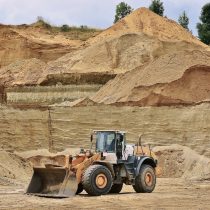
Incorporating electromobility and energy efficiency, promoting Non-Conventional Renewable Energies (NCRE), promoting greater responsibility of mining with respect to its emissions and encouraging research and development in these lines of action are part of the transformation route that the University of Chile, through Beauchef Minería, dependent on the Faculty of Physical and Mathematical Sciences (FCFM), proposes through the report “Mining and Climate Change”.
The work, led by professors Willy Kracht and Bárbara Salinas, and which had the contribution of numerous academics and researchers of the FCFM, proposes that an action plan for the reduction of emissions under these guidelines would position Chilean mining, and particularly copper, as a differentiated and clean product, while generating a new market.
The study, corresponding to the third installment of a series of studies on Mining, Technology and Society, addresses the commitments and challenges that climate change represents for Chilean mining. Specifically, it offers an updated look at industry statistics, trends, vulnerabilities to climate change and projected demands for different minerals, while showing the relationship between the energy transition, electromobility issues and mining, where the base focuses on mitigating the effects of climate change.
This process imposes important challenges, especially for copper mining, because, being a key metal for the development of clean technologies, its demand will experience an estimated increase of about 50% globally by 2050, which will be accompanied by a growth of the mining industry and an increase in electricity consumption of over 41% by 2029.
Energy in mining: a priority approach
“Energy efficiency, unlike what is usually proposed, is presented as an option with great potential, as long as the appropriate incentives are generated and there is greater knowledge regarding its implementation,” says Professor Rodrigo Palma, academic of the Department of Electrical Engineering and director of the Energy Center, in the foreword to this work.
“On the other hand, the document embraces the unique opportunity of solar energy in its various forms, without neglecting the contributions of other renewable energies, electromobility and hydrogen as an energy carrier. All this analysis is carried out considering the impacts that the development of these technologies could eventually have at a local level, where the ‘lithium dilemma’ is highlighted as an unresolved trade-off between carbon footprint and water footprint, “he explains.
Currently, the energy sector is responsible for 78% of greenhouse gas emissions, and electricity consumption accounts for more than 70% of mining emissions.
In this way, the report warns that “the mining sector is intensive in the use of energy, a situation that will worsen, due to the fact that the deposits are becoming deeper, with decreasing laws and with greater hardness of the rock, so that energy consumption will increase (Fundación Chile, 2016). In addition, open pit mines will be deepened, requiring more sterile material to be moved per ton of treated material and at a greater distance, increasing the use of diesel. Another factor that will increase energy consumption is desalination.”
Willy Kracht, director of the Department of Mining Engineering at the U. of Chile and member of Beauchef Minería, comments that copper is also a key element for the development of clean technologies and states that “there is a demand for more mining in the progress towards the energy transition, which is inescapable. So, we visualize that if there is an energy matrix based on clean technologies, being intensive in the use of minerals, copper is important in it. There is a challenge of sustainable production, clean production from the mining perspective.”
It also highlights that mining is intensive in the use of fuel and electrical energy. “In fact, it demands about 1/3 of the electricity produced in the country and 20% of the diesel consumption nationwide. Therefore, we have to take care of direct and indirect emissions.” In this line, he adds that as a country we have important advantages for the generation of renewable energies, since we have high levels of radiation for the generation of solar energy, in a region thatand is also close to where large mining operations are located,” he says.
The document indicates that “although we generate only 0.25% of global emissions, Chile produces almost 30% of the world’s copper, so if our efforts were concentrated on mining, the contribution to world copper production would be very relevant.” In this sense, Willy Kracht emphasizes that a transformation of the mining sector is necessary to account for the challenges of climate change, “that although at the local level the contribution to the global environment is small, it does not detract from the responsibility we have in such an important issue for the entire planet”.
Transformation towards cleaner mining
For her part, Bárbara Salinas points out that the Beauchef Minería study becomes even more relevant today in the context of the recent publication of the latest IPCC report, with rather hopeless conclusions, which puts climate change as an even greater urgency than it had when it was written. That is why a mining transformation route is proposed that aims to reduce emissions with a focus on energy.
“To comply with the Paris Agreement, energy transformation is inescapable. If we want to limit the increase in temperature we must reach carbon neutrality by 2050, for which the main measures that have been promoted are the transformation of the energy matrix and electromobility, “says the document.
“Chilean mining, which today is directly or indirectly responsible for about 21% of the country’s CO2 emissions, cannot be left out of this global commitment. In addition, copper is a strategic mineral for the development of clean technologies that are being promoted globally to reduce emissions, so it is logical to think that this metal should be extracted in the most sustainable way possible”, explains the academic about the growing importance that this metal will have for decarbonization, for example, through the development of NCRE and electric vehicles.
In this regard, the report reveals that 74% of the total demand for copper will be used for the development of solar and wind generation technologies, however, it is likely that this estimate is significantly underestimated, since it does not include infrastructure requirements, such as transmission systems, nor the growth of the world’s population.
Salinas says this could benefit both Chile (because the country’s emissions will be reduced) and the mining industry, “not only because it would be able to deliver a clean and differentiated product, but also more competitive in a world where people are increasingly concerned about the procedure of the goods they consume. By being responsible for about 30% of the world’s copper production, we could become an example for mining to become a cleaner industry.”
In this sense, he affirms that Chile has wide advantages to become a renewable energy power in the region through solar energy and green hydrogen. “Given that green hydrogen is still an emerging market compared to other clean technologies, a great opportunity for local development is envisioned for northern Chile, a place that has important advantages for its production. In this way, it would be a solution for heavy machinery in mining, which is currently not possible to power with lithium batteries,” he says.
To this he adds that hydrogen, in addition, could be a less problematic technology than lithium, “because it requires a small amount of water in its production, an industry that is experiencing conflicts with the communities of the north over this issue”.
The academic believes that it is time for Chile to take the advantages that its geography gives it in the production of renewable energies to innovate and develop technology at the local level, instead of continuing to import and adapt it to the national reality.
“Leveraging the circular economy approach in mining to generate local recycling markets for lithium batteries and hydrogen cells could be a new development boost for our country. Like lithium batteries, if hydrogen fuel cells are not recycled, they can become not as sustainable as they seem. In this area, our country could integrate the concept of circular economy and the production of fuel cells, taking advantage of the fact that it is a market that is still developing and there is much to investigate and innovate in this regard, “he concludes.
The study is available on the Beauchef Mining website and is freely accessible.





